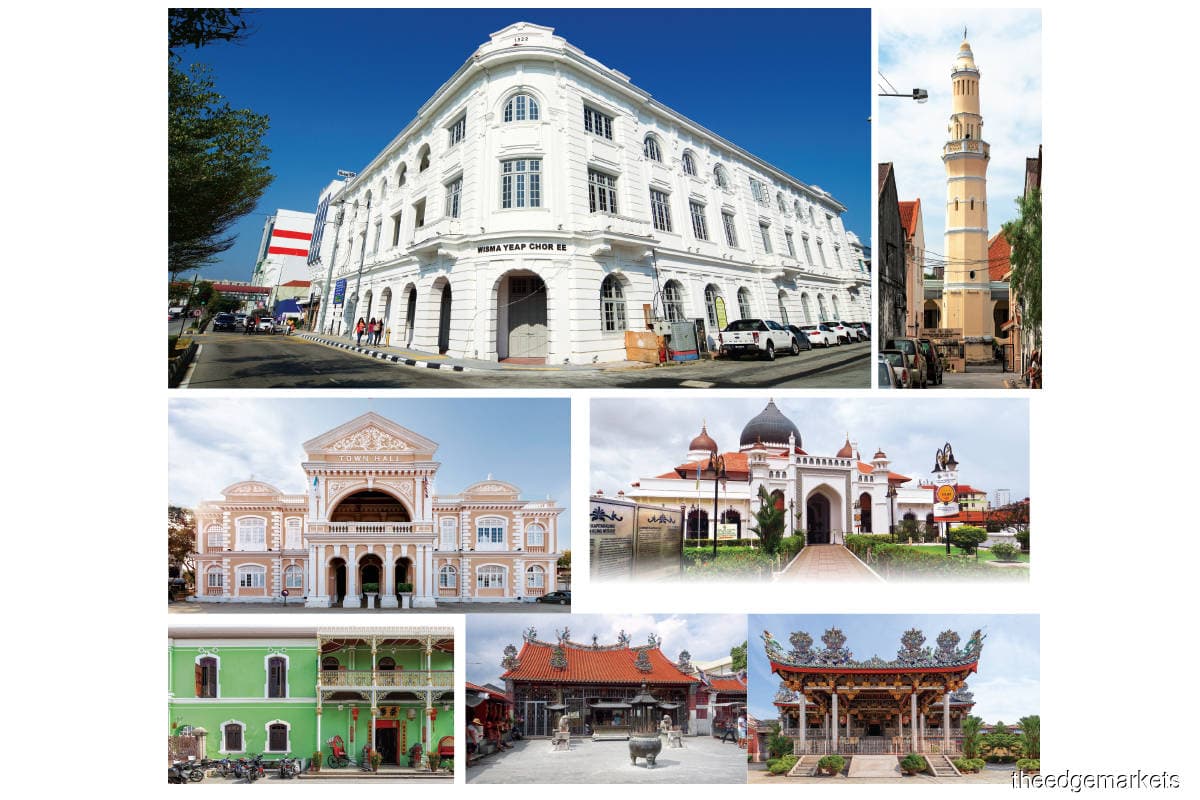
This article first appeared in City & Country, The Edge Malaysia Weekly on January 10, 2022 - January 16, 2022
Penang’s capital, George Town, was listed as a Unesco World Heritage site in 2008. It was named after King George III and is one of the most interesting historical cities in Malaysia, with atmospheric streets lined with heritage architecture. We take a look at the George Town Heritage Trail, which highlights several tourist-worthy attractions.
1 Wisma Yeap Chor Ee
Built in 1922, Wisma Yeap Chor Ee was constructed by Chinese tycoon Yeap Chor Ee, who had business interests in tin mining, rubber and sugar. The three-storey complex has a whitewashed and rusticated exterior façade, allowing it to blend in with the colonial architecture prevalent along Weld Quay.
Yeap was 55 at the time of its construction. According to penang.fandom.com, the complex, part of which faces the Port of Penang, used to house his offices. Over the following decades, it housed other mercantile offices that dealt primarily with the booming entrepôt trade.
The building was also home to the Rainbow Art Gallery, one of the few art galleries in Penang at the time. It served as a set for the famous espionage period film — Lust, Caution — in 2006. It underwent restoration works after the film was shot and now houses the Penang Science Cluster, a science-themed café founded by the Penang state government, according to heng-lee.com.
3 Pinang Peranakan Mansion
The Pinang Peranakan Mansion on Church Street is a museum dedicated to the Peranakan heritage in Penang. Formerly called Hai Kee Chan, meaning Sea Remembrance Hall in Penang Hokkien, by Chinese tycoon Chung Keng Quee, the mansion once served as his residence and office. Though he was not a Baba, his Chinese courtyard house was like a typical large Peranakan home of eclectic style, incorporating Chinese carved-wood panels, English floor tiles and Scottish ironworks, according to penang.ws.
The mansion was passed on to his descendants after his death in 1901. However, it gradually became derelict and was later acquired by a property developer in the 1990s, who repainted it green.
After its restoration, the museum now displays more than 1,000 pieces of Peranakan artifacts, antiques and collectibles. It also showcases Peranakan interior design and customs. Due to its unique architecture and interior design, which reflect the lifestyle of the Peranakans in Penang, the mansion has been featured in television dramas and reality shows, including The Little Nyonya and The Amazing Race Asia, according to pinangperanakanmansion.com.
5 Masjid Kapitan Keling
Built in 1801 by Indian Muslim traders, Masjid Kapitan Keling is located at the junction of Lebuh Buckingham and Jalan Masjid Kapitan Keling. It used to occupy 18 acres but now only covers eight as part of the land was claimed by the government for road construction.
According to penang.ws, the Indo-Moorish structure was named after Cauder Mydin Merican, who was the headman, or Kapitan, of the Indian Muslim community back then. The word “keling” is derived from the ancient Hindu kingdom on the Coromandel coast of South India, and was also used for the people who hailed from there. As the Indians had difficulty in
pronouncing English words, “Captain” was translated into “Kapitan”.
Topped with large Mughal-style domes, crescents and stars, the whitewashed mosque boasts architecture with Gothic, Moorish and Roman Renaissance influences as well as calligraphy panels and stained-glass windows. It houses a single, typical Indian-Islamic minaret from which the sound of the azan (call to prayer) can be heard.
In order to accommodate the growing population, the mosque was renovated in 1916 to increase its capacity, with additional Mughal domes and turrets, a large minaret and a madrasah, and ultimately became the largest mosque in Penang.
7 Khoo Kongsi
Khoo Kongsi, also known as Leong San Tong Khoo Kongsi, is one of the most distinctive Chinese clan associations in Malaysia. It is known for its extensive lineage, which can be traced back 650 years, as well as its buildings and magnificent clan house.
According to khookongsi.com.my, Khoo Kongsi, together with the Cheah, Yeoh, Lim and Tan Kongsi, were known as the five big clans (Goh Tai Seh) who formed the backbone of the Hokkien community during Penang’s olden days. Having identified their respective bases, they rooted themselves in an area stretching from Chulia Street Ghaut in George Town to the lower part of Beach Street (Lebuh Pantai) in the south, in the mid-19th century.
With the respective clan houses as the nuclei, these kongsi demarcated their territories with their own terraced houses on three or four sides of the perimeters. This adjoining, closely-knit and defensive model settlement is a rare form of congregation practised among migrant communities.
Khoo Kongsi now serves both as a temple and museum, and is a must-visit destination for those who are into history and architecture.
Save by subscribing to us for your print and/or digital copy.
P/S: The Edge is also available on Apple's AppStore and Androids' Google Play.







